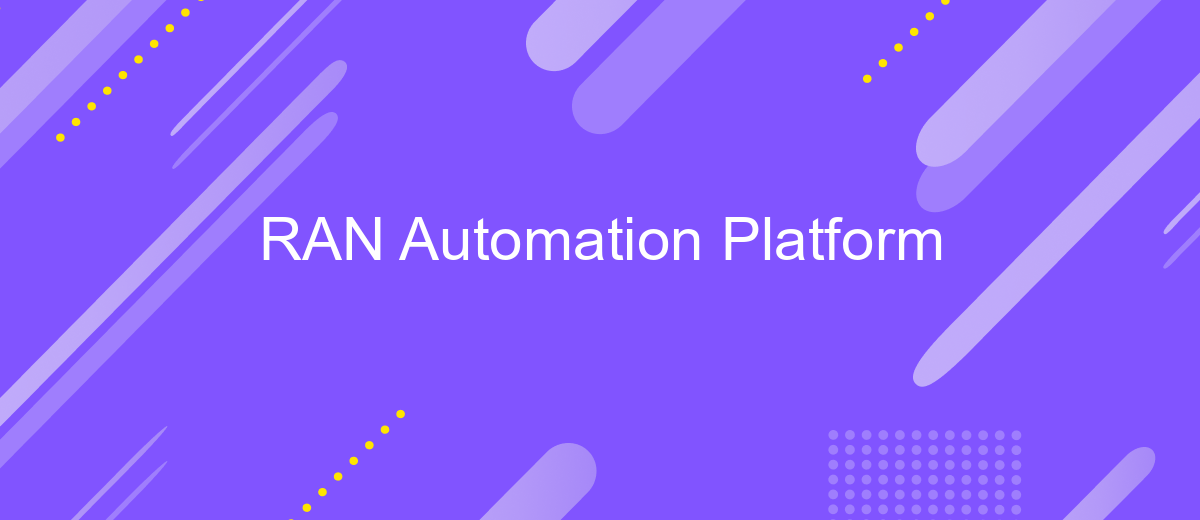RAN Automation Platform
The RAN Automation Platform is revolutionizing the telecommunications industry by streamlining network operations and enhancing service delivery. By integrating advanced automation technologies, this platform enables operators to efficiently manage radio access networks, reduce operational costs, and improve network reliability. With its scalable and flexible architecture, the RAN Automation Platform is poised to meet the growing demands of modern communication networks, paving the way for future innovations and seamless connectivity.
Introduction to RAN Automation Platforms
Radio Access Network (RAN) Automation Platforms are revolutionizing the telecommunications industry by enhancing network efficiency and reliability. These platforms leverage advanced technologies such as artificial intelligence and machine learning to automate and optimize network operations. The primary goal is to reduce operational costs, minimize human intervention, and improve overall network performance. By automating routine tasks, RAN Automation Platforms enable faster deployment of services and quicker adaptation to network demands.
- Automated network configuration and optimization
- Real-time monitoring and predictive maintenance
- Enhanced energy efficiency and cost savings
- Improved service quality and user experience
- Scalable solutions for evolving network demands
As the demand for high-speed connectivity continues to grow, RAN Automation Platforms play a crucial role in meeting these needs efficiently. They provide a scalable and flexible approach to managing complex network infrastructures, ensuring seamless communication and connectivity. By embracing these platforms, telecom operators can stay competitive in a rapidly evolving digital landscape, offering enhanced services to their customers while maintaining operational excellence.
Key Features and Capabilities

The RAN Automation Platform offers a comprehensive suite of features designed to enhance network efficiency and performance. One of its key capabilities is intelligent network optimization, which utilizes AI-driven algorithms to dynamically adjust network parameters, ensuring optimal performance even during peak usage. This platform also supports seamless integration with existing network infrastructure, allowing operators to deploy automation solutions without significant overhauls. Additionally, its real-time monitoring and analytics provide actionable insights, enabling proactive maintenance and reducing downtime.
Moreover, the RAN Automation Platform excels in its ability to facilitate easy integration with third-party applications and services. By leveraging tools like ApiX-Drive, it simplifies the process of connecting various network components and external systems, streamlining workflows and enhancing operational efficiency. The platform's user-friendly interface and customizable dashboards ensure that network operators can tailor the system to meet their specific needs, making it a versatile solution for modern telecommunication challenges. Overall, the RAN Automation Platform empowers operators to deliver superior network performance and reliability.
Benefits of RAN Automation

RAN Automation offers transformative benefits for modern telecommunications networks. By automating routine tasks, it reduces operational costs and minimizes human error, leading to more reliable network performance. This automation also allows for faster deployment and scaling of network resources, meeting growing demands efficiently.
- Enhanced Efficiency: Automation streamlines network operations, allowing for quicker response times and improved service delivery.
- Cost Reduction: By minimizing manual interventions, companies can significantly cut down on operational expenses.
- Improved Accuracy: Automated systems reduce the risk of human error, ensuring more accurate and consistent network management.
- Scalability: Automation facilitates the rapid scaling of network infrastructure to accommodate increasing user demands.
- Real-time Monitoring: Automated platforms provide continuous monitoring and analytics, enabling proactive issue resolution.
In conclusion, RAN Automation is a crucial advancement in telecommunications, offering a competitive edge through enhanced operational capabilities and cost efficiencies. By embracing these technologies, service providers can ensure robust and scalable networks that meet the dynamic needs of today’s digital landscape.
Use Cases and Deployment Scenarios

The RAN Automation Platform is revolutionizing how telecom operators manage their networks by automating routine tasks and optimizing resource allocation. This platform enables operators to improve network efficiency, reduce operational costs, and enhance user experience. By leveraging AI and machine learning, the platform can predict network issues and resolve them proactively, ensuring seamless connectivity.
Deployment of the RAN Automation Platform can be tailored to various network environments, making it versatile for different operational needs. Operators can choose between cloud-based, on-premises, or hybrid deployments, depending on their infrastructure capabilities and business goals. This flexibility ensures that the platform can be integrated smoothly into existing systems without disrupting operations.
- Automated network optimization for improved performance and reduced latency.
- Predictive maintenance to prevent network failures and minimize downtime.
- Dynamic resource allocation to handle fluctuating network demands efficiently.
- Real-time analytics for informed decision-making and strategic planning.
The RAN Automation Platform's use cases extend beyond traditional telecom operations. It supports emerging technologies like 5G and IoT, enabling operators to manage complex networks with ease. By adopting this platform, telecom companies can stay competitive and meet the growing demands of modern digital communication.


Future Trends and Challenges
The future of RAN Automation Platforms is poised for transformative growth, driven by advancements in artificial intelligence and machine learning. As networks become more complex, the demand for automated solutions that can efficiently manage and optimize these systems will increase. The integration of AI-driven analytics will enable real-time decision-making, enhancing network performance and reducing operational costs. Additionally, the shift towards open RAN architectures will facilitate greater flexibility and innovation, allowing operators to customize their networks to meet specific needs.
However, this evolution is not without its challenges. Security concerns remain a significant hurdle, as the increased automation and connectivity expose networks to potential cyber threats. Moreover, ensuring seamless integration between various components and systems is crucial. Services like ApiX-Drive can play a vital role in this context by providing reliable integration solutions that streamline the process of connecting disparate systems. As the industry navigates these challenges, collaboration among stakeholders will be essential to harness the full potential of RAN Automation Platforms.
FAQ
What is RAN Automation Platform?
How can RAN Automation Platform benefit telecom operators?
Is it possible to integrate RAN Automation Platform with existing systems?
What types of tasks can be automated with RAN Automation Platform?
What are the key features of RAN Automation Platform?
Apix-Drive is a universal tool that will quickly streamline any workflow, freeing you from routine and possible financial losses. Try ApiX-Drive in action and see how useful it is for you personally. In the meantime, when you are setting up connections between systems, think about where you are investing your free time, because now you will have much more of it.

